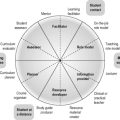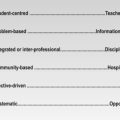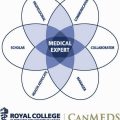27 Peer and collaborative learning
Definition
P2P Learning
P2P learning has been defined by Topping (1996) as ‘people from similar social groupings who are not professional teachers helping each other to learn and learning themselves by teaching’. One student assumes the role of teacher or tutor while other students assume the role of learners or tutees. Students may switch their role from tutor to tutee. Usually, to guide students in their role as tutor, some instruction is given in teaching skills.
Examples of P2P and collaborative learning
• Students are given the role of tutor in slots scheduled in the curriculum.
• Students form informal partnerships to assist each other.
• Students work in groups in the context of problem- or team-based learning.
• Students work in pairs facilitating each other’s learning.
• Students collaborate in a project or in practical work such as anatomical dissection.
• Students work as members of an inter-professional group in a community-based project.
• Students work online as members of a formal discussion group with a specific task as the focus.
• Students share their experiences and information with others through a social network such as Facebook.
• Students collaborate in the development of educational resources or textbooks that they share with others.
• Students have the responsibility for assessing each other’s achievements in an area such as professionalism (peer assessment).
• Students in more senior years or junior doctors teach junior students.
Benefits to be gained by P2P and collaborative learning
• Students can learn effectively from their peers, in particular where there are problems relating to complex learning and concept manipulation.
• Learning outcomes less easily achieved through other methods are promoted. These include interpersonal skills, communication skills, higher level thinking skills, skills of critical appraisal and team working skills.
• Students are helped to develop their confidence and self esteem.
• Students are prepared for life-long learning as the classroom more closely resembles real-life social and employment situations.
• Students’ satisfaction with the learning experience is enhanced with a more positive attitude developed towards the subject matter.
• Students are encouraged to appreciate diversity and to reflect and appreciate different viewpoints and perspectives brought to the discussion by other students.
• Learners working online at a distance have a supportive community environment.
• Additional support for student learning is provided at a time when there is pressure on staff:student ratios.
• An educational environment is created within the institution where collaboration is valued.
• A student-centred learning approach is supported with students taking more responsibility for their own learning.
• Teaching is a powerful learning tool – ‘to teach is to learn twice’.
• Students’ skills as teachers are developed in line with recommendations from accrediting bodies that medical graduates must be able to demonstrate appropriate teaching skills.
• Students feel engaged and have some ownership of the curriculum.
• The concept of the student as an assessor of other students is supported, in particular in areas such as attitudes and professionalism.
• Students receive significant feedback as part of the learning activity which is not always possible in other situations, particularly in large group learning.
• Experience gained as a student teacher may encourage some students to seek an academic career.
Implementation in practice
P2P Learning
The following tips contribute to successful P2P learning:
• Incorporate P2P learning formally into the curriculum and do not consider it only as an add-on extra.
• Schedule the P2P sessions and make the necessary arrangements for students to sign up.
• Decide whether students’ attendance is obligatory or whether the P2P sessions are optional.
• Ensure that both the tutors and tutees are aware of how P2P learning contributes to the mastery of the learning outcomes of the course. It is sometimes claimed that the tutor gains as much if not more than the tutee. This includes mastery of teaching skills.
• Ensure that student tutors are fully briefed and have training in the necessary skills. They may be assisted with the provision of learning resources to support the learning.
• P2P tutors should have ongoing mentoring and coaching by staff.
• Choose the form of P2P learning that is most appropriate for your situation. This may involve students in the same year or more senior students or junior doctors acting as tutors.
• In planning and organising P2P learning, a team approach involving both staff and students is useful.
• As with all learning experiences P2P learning should be monitored and evaluated.
Collaborative learning
The success of collaborative learning can depend on how it is implemented:
• Explain to the students the benefits of the collaborative learning approach and the expected learning outcomes, including the development of interpersonal skills and mastery of the subject content. It is important that they accept them.
• Collaborative learning can be at its most effective with heterogeneous groups where students tend to interact and achieve more compared to working with students more closely matched in their abilities and background.
• The learning tasks can be structured so that students must depend on each other for completion of the task. This involves within the group trust building, conflict management, encouragement and negotiation. Each student should be held accountable for doing their own share of the work. One inter-professional group we saw, as described in Chapter 13, worked well because the solution to the problem presented required the theoretical knowledge of the medical student members of the group and the practical knowledge of the midwives.
• It is important that sufficient time is allocated to collaborative learning. Students need to complete the required tasks and achieve the expected learning outcomes. This creates an atmosphere of achievement in the group. Some of the social benefits may become apparent only after the group has worked together for a number of weeks.
• Students should have the opportunity within their small group to reflect upon and reply to the diverse responses from other group members. The exchange of views in the group should help students to understand better the issues and concepts being discussed.
• It is important to recognise that just because students are working in small groups it does not mean that they are engaging in collaborative learning. It needs to be ensured that students are cooperating with regard to their own learning and the learning of others in the group.
• Each member of the group should contribute to the work and product of the group so that the end result will be better than that achieved by one student, even the best, working independently.
• Encourage students in the group to explain concepts or principles to others and for the explanation to be discussed by the group. This can lead to effective learning for the members of the group.
• The group activities should be organised in such a way that the learning success of each individual and the group as a whole is recognised. We saw this achieved in one setting where an individual was chosen by the teacher at random at the end of the week to present the work of the group. The group was given a mark based on the individual’s presentation. The group had to ‘sink or swim’ together.
• Monitor the group activity and the progress being made by the students in the group. The teacher, when facilitating a group should provide assistance and clarification if required. It is important that the teacher does not dominate the session and convert it into a mini-lecture.
Reflect and react
1. You may feel uncomfortable delegating teaching responsibilities to a student or trainee. There is overwhelming evidence that this can be effective. Consider how it can be adopted in your situation.
2. Which of the advantages of P2P or collaborative learning listed above apply in your situation?
3. Look at the learning outcomes for your course or curriculum and consider whether some outcomes such as team work could be usefully addressed through P2P or collaborative learning.







